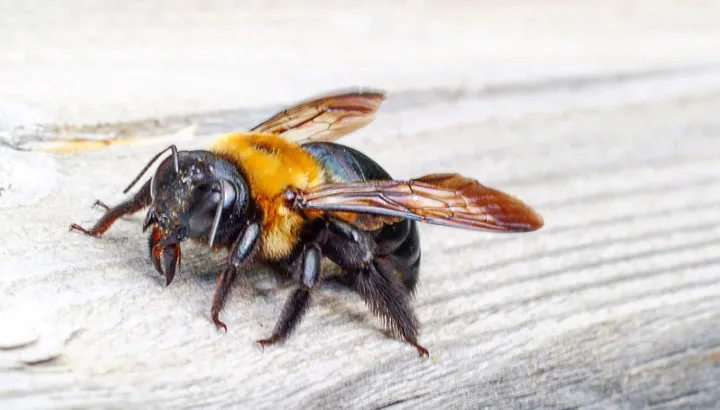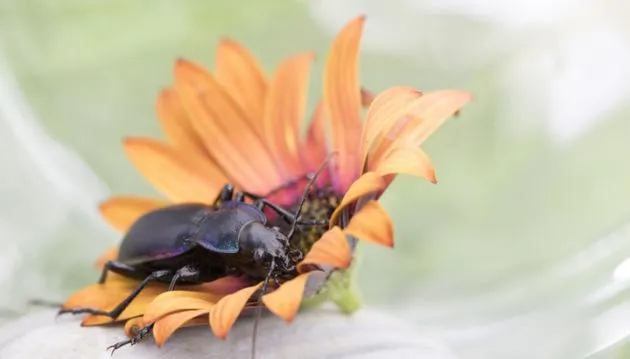I’m a sucker for bees — they’re just incredible. Within my yard, I’ve created a bee-friendly environment, allowing me to sit outside and watch them dance around various flowers — like this carpenter bee that came to visit me the other day.

As I became more interested in pollinators, as well as a number of other common garden species, I quickly realized that we benefit from one another.
Insects are often viewed as nothing more than creepy crawlers — but they’re much more than that. If you want to create and maintain a thriving garden, it’s important to welcome certain species into your yard. You can actually encourage certain insects to do some of the “heavy lifting” — eliminating your reliance on harmful chemicals, while reducing any lost vegetation and/or damage to flowering plants.
Why do we need insects?
Before we get into specifics, it’s critical that we highlight the true importance of bugs — even those that you find to be unsightly. Think of it this way: out of every animal species on earth, nine out of 10 are insects. They most certainly serve a purpose and whether you believe it or not, they deserve a much better reputation.
When it comes to gardening and farming, there are a long list of pests that can interfere — caterpillars, grasshoppers, aphids, and more. On the other hand, there are ‘good’ insect-eating insects which counterbalance these problematic populations. From recycling animal waste to spreading pollen, we need insects. Encourage a healthy garden by welcoming these five species:
1. Ladybugs
Known for their stunning bright red shells, ladybugs are feistier than they are cute. Although they’re pleasing on the eye, these small insects feed on plant-eating insects. In turn, they help protect your crops and flowers. After laying hundreds of eggs in a colony of aphids, a lady bug will leave her young larvae to feed on these pests.
Acting as an effective, all-natural solution, ladybugs help you eliminate the use of any chemical pesticides. In order to attract more ladybugs, you will need two things — specific plants and pollen, as well as bugs for them to feast on. Although this seems counterintuitive, attracting aphids with ‘decoy’ plants, can help attract ladybugs so that they can get down to business.
To attract ladybugs: Add more plants, including dill, chives, fennel, marigold, angelica, calendula, and sweet alyssum. To ensure ladybugs have food, while distracting pests from the plants you’re trying to protect, plant early cabbage, radish, marigold or nasturtium.
2. Bees
Due to their stinging ability, people are often fearful of bees. The truth is, they’re remarkable creatures that play a critical role in terms of our food system. Without them and other key pollinators, we would not be able to enjoy the wide variety of fresh produce we currently have access to.
Unfortunately, due to the heavy use of pesticides, bee populations are dying off at alarming rates. Considering neonicotinoid pesticides also affect the human hormonal and nervous system, numerous groups are working hard to ban these harmful chemicals.
When you help pollinator colonies grow, you’re not only helping your own garden, but the entire global food supply. Bees, the most important pollinators, spend around 10 hours a day bouncing from flower to flower. As they collect pollen, they help increase crop production.
To attract bees: First of all, before you do anything to influence your yard, you can make a large impact by opting for organic. Not only will you benefit in terms of your own personal health, but you will essentially be voting to support farmers who do not use heavy chemicals which pollute the water system, threaten wildlife and impact human health.
Within your own garden, provide pollen and nectar-rich plants, such as lavender and sedums. Clump these plants together in a sunny area, as this is more attractive and effective than scattered plants that are shaded. Also, provide bees with a nesting site or a “home” for them to truly benefit and thrive. Check out this interesting video to make your own bee bath or bee home.
3. Ground beetles
Amazingly, there are over 2,500 species of ground beetles, which tend to be dark with a shiny, hard shell. Although they vary in color, they are usually black or brown, showcasing a metallic back. They feed on a number of pests, including slugs, cabbage maggots, cutworms, snails and more. In fact, one beetle larvae can consume more than 50 caterpillars.
To attract ground beetles: Plant perennials and groundcovers while focusing on two things — water and shelter. Since they’re nocturnal, ground beetles benefit from rocks or even a brick, so that they can hide during the day. They also love mulch, which is an attractive addition to any garden.
Like the bee bath above, ground beetles love a shallow dish of water with gravel inside. The gravel is essential so that they do not drown. Since stagnant water can attract mosquitoes, be sure to change frequently. Also, solar lights will help attract pest-eating beetles — but do not use bug zappers as a light source.
Within a Canadian study, researchers found that for every eight or so mosquitoes killed, up to 10,000 other insects fell victim. Meaning, approximately 97 percent of the insects killed were not biting mosquitoes. Remember, ecosystems need to be balanced and when aiming to avoid certain pests, you need to protect others.
4. Earthworms
For all you gardeners, you know that when you see big ol’ earthworms, your soil is healthy. Earthworms are most certainly your best friend and the more of them you have, the better your soil is. Producing what’s known as castings, earthworms offer an excrement that enriches the soil.
More importantly, due to the way they travel, earthworms create little tunnels that help increase the amount of water reaching the roots of plants. Also, “worm-composting” or vermiculture — will help you convert your kitchen scraps into quality compost.
To attract earthworms: One of the easiest, most cost effective ways to improve your soil and keep earthworms happy, is to add more organic matter, including stems, roots and leaves. In the video below, you’ll learn how to make a worm farm in four easy steps.
5. Praying mantis
I’ll never forget the first time a praying mantis crawled up my leg. Being a kid from the country, I was exposed to a lot of bugs — many of which intrigued me. The praying mantis, however, freaked me out — especially once I learned what females do to males after they bred. Nothing like the tasty head of your partner for dinner.
In terms of your garden, nothing will fix a pest problem quite like praying mantis — they’re the ultimate predator.
Although they often feast on grasshoppers, aphids, leafhoppers, flies and crickets, they have also been known to eat small tree frogs and even mice. They will, however, also eat some beneficial insects — so keep this in mind when aiming to achieve a healthy ecological balance.
To attract praying mantis: You can actually visit your local nursery in order to inquire about sustainable practices, including praying mantis eggs. Each egg will hatch around 200 babies. Once you take all the proper steps, these carnivores require a good hiding spot, so plant some ground cover, such as hostas.
So remember, insects can most certainly be your friend — work together to create the garden of your dreams.
WANT MORE AMAZING GARDENING TIPS? CLICK HERE !
— Krista Hillis

